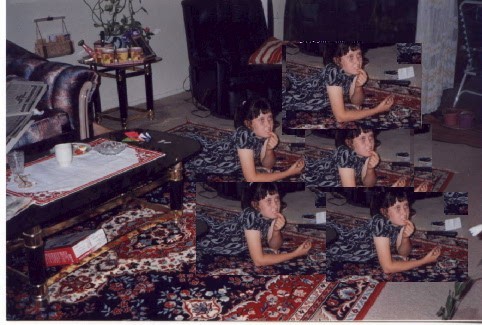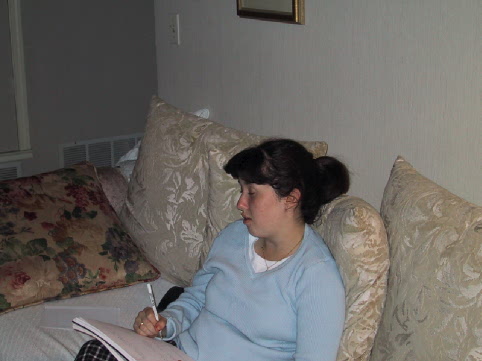|
Do you know
the joys of online
'Math-satting'?
I would like to take
this opportunity dedicating a special'Math-Sat' page to my dear granddaugther Alex .
First of all , I believe that following
facts about numbers , algebra and geometry might be helpful saving an excessive amount of time pondering over simple
problems .
Some facts about numbers
:
1. An odd integer power of a negative number is negative, and an even integer power
is positive;
3
2
for example, (-2) = -8, but (-2) =4.
2.Squaring a number between 0 and 1 (or raising it to a higher power) results in
a smaller number;
for example,
2
3
(1/3) = 1/9, and (0.5) =0.125
3. The sum of an odd integer and an even integer is odd.
4. If an integer P is a divisor ( or a factor) of another integer N, then
N is the product of P and another integer, and N is said to be a multiple of P; for example, 3 is a divisor
( or a factor) of 6, and 6 is a multiple of 3.
5. A prime number is an integer that has only two distinct positive divisors,
1 and itself ;
for example , 2,3,5,7, and 11 are primes, but 9 is no a prime
because it has three positive divisors : 1,3, and 9.
6. The sum and product of signed numbers will be positive or negative depending on the
operation and the kinds of numbers ;
for example , the product of a negative number and a positive number is negative.
7. For any two numbers on the number line , the number on the left is less than the number on
the right;
for example ,2< 3 and -4 <- 3
n
8. If n is a positive integer, than x denotes the product of
n factors of x;
4
for example ,3 means 3.3.3.3 =81
0
9. Note also that 3 =1 , and that division by zero is undefined; that is , 5/0 has no meaning.
Some facts
about algebra :
1. If ab = 0 , then either a =0 or
b=0;
for example , if ( x-1) ( x+2) =
0, it follows that either x-1=0 or x+2=0. Therefore, x=1 or x=-2.
2. Adding a number to or substracting a number from both sides of an equation preserves
the equality.
3. Multiplying or dividing both sides of an equation by a nonzero number preserves
the equality.
4. Note that multiplying or dividing both sides of an inequality by a negative
number , the inequality reverses;
for example, multiplying the inequality
3x-4>5 by -4 yelds -12x + 16 < -20.
5. The following rules for exponents are useful. If r, s, x, and y are positive
integers , then
s r
x+s 2 4
6
a) x . x = x
; e.g. 3 . 3 = 3 = 729
b) x . y = ( xy ) ; e.g.
3 . 2 =6 = =1,296
r s rs 3
4 12
c) ( x ) = x ; e.g. (2 )= 2 = =4,096
r s
r-s 5 2 3
d) x / x = x ; e.g. 4 / 4 =4=64
Some facts about geometry
1.The number of the degrees of arc in a circle is 360 ; thus, the length of an arc of 60 degrees will
be 60/360 =0.166 of the circumference of the circle (2 *Pi * R ).
2.The sum of the degree measures of the angles of a triangle is 180.
3.The volume of a rectangular solid or of a right circular cylinder is the product of the area of the base and the height;
for example, the volume of a cylinder with base of radius 2 and height 5 is
2
Pi(2 ) (5) = 20 (Pi)
4. The square of the length of the hypotenuse of a right triangle is equal to the sum of the squares of the lengths
of the two legs.
5. The coordinates of a point ( x,y) give the location of the point in the coordinate plane;
for example, the point (2,-3) is located in the fourth quadrant 2 units to the right of the Y-axis
and three units below the
X-axis .
6.The sides of a 45 - 45- 90 triangle are
_
the ratio 1 : 1 : \/2 .
7.The sides of a 30 - 60- 90 triangle are
_
the ratio 1 : \/3 : 2 .
Note that the above mentioned facts and rules should be automated in
use !
Now , it's just the time to take a diagnostic test in the area of 'quantitative comparison'
problems ( QC).
WHAT IS ' Q C ' ABOUT ?
The quantitative comparison questions
test the ability to reason quickly and accurately about the relative sizes of two quantities or to perceive that not enough
information is provided to make such a decision. To solve a quantitative comparison problem, you compare the quantities given
in two columns. Column A and Column B, and decide whether one quantity is greater than the other, whether the two quantities
are equal, or whether the relationship cannot be determined from the information given. Some questions only require some manipulation
to determine which of the quantities is greater; other questions require you to reason more or to think of special cases in
which the relative sizes of the quantities reverse.
The following strategies might
help in answering quantitative comparison questions.
1. Do not waste time performing needless
computations in order to eventually compare two specific numbers. Simplify or transform one or both of the given quantities
only as much as is necessary to determine which quantity is greater or whether the two quantities are equal. Once you have
determined that one quantity is greater than the other, do not take time to find the exact sizes of the quantities. Answer
and go on to the next question.
2. If both quantities being compared involve no
variables, then the correct answer can never be (D), which states that the relationship cannot be determined. The answer is
then reduced to three choices.
3. Consider all kinds of numbers before you
make a decision. As soon as you establish that quantity A is greater in one case while quantity B is greater in another case,
choose answer (D) immediately and move on to the next comparison.
4. Geometric figures may not be drawn to
scale. Comparisons should be made based on knowledge of mathematics rather than appearance. However, you can sometimes find
a clue by sketching another figure in your test book. Try to visualize the parts of a figure that are fixed by the information
given and the parts that are collapsible and changeable. If a figure can flow into other shapes and sizes while conforming
to given information, the answer is probably (D).
To review some algebra lessons
and solutions , go to :


During the preparation of the test try to imitate
all the details of the Sat- environment: work on a small table having on it the items shown in the picture
bellow: calculator, rule,protractor et c. I believe that the shown work positions are not perfectly appropriate
to the above mentioned recommendation ... By the way, do you remember how to deal with a protractor
measuring an angle?
Voila
some Mathematical
Sophisms
Take a look, please,
and figure out what's wrong in the following evaluations:
1. 2 x 2
= 5 ?
What is wrong
in this evaluation ?
Suppose a
= b + c ; Multiplying the
both sides of the equation with 5 we
get
5a = 5b + 5c ; if we do the same operation
with 4 , we get :
4b + 4c = 4a ; Putting together respectively the equalities
,
4b + 4c + 5a = 5b + 5c + 4a ;
Substracting from both sides 9a
,
4b + 4c - 4a = 5b + 5c -
5a
4 ( b + c - a ) = 5 ( b + c - a ) ;
Reducing both sides by (b+c-a) ,
4 = 5 or
2 x 2 = 5 !
2.
4 dollars = 400 dollars ?
What's wrong in this evaluation ?
2 dollars = 2 dollars;
2 dollars = 200 cents ; Rising both sides with exponent 2, we get:
4 dollars = 40,000 cents
; since 1 dollar equals to 100 cents,
4 dollars = 400 dollars
!
3. Are all the odd numbers
equal to 1 and all the even numbers equal to 0 ?
( -1) 2 n =1 ; 2n log(-1)= log(1) =0;
therefore,
either 2n = 0 , or
log (-1) =0
2n = 0
Now, ( -1)2n+1 =-1 ;
(2n+1) log
( -1 ) =log(-1)
2n +1 = 1 WHAT 'S WRONG
THERE ?
4
Is i2 =1
?
Suppose, a isn't equal to b ; ( a b )1/2 = i ( b a ) 1/2
And
( b a ) 1/2 = i ( a b )
Multiplying we get : ( ab) = i 2 ( ba ), or i 2 = 1
WHAT 'S WRONG THERE ?
To see the right work position click here
How to measure an angle using a protractor?
With best wishes of success and prosperity,
Grandpa
|

